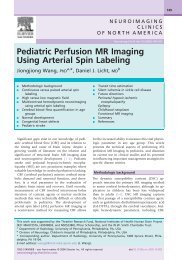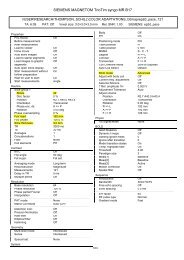Arterial Spin Labeling Perfusion MRI Signal Processing Toolbox ...
Arterial Spin Labeling Perfusion MRI Signal Processing Toolbox ...
Arterial Spin Labeling Perfusion MRI Signal Processing Toolbox ...
Create successful ePaper yourself
Turn your PDF publications into a flip-book with our unique Google optimized e-Paper software.
4.3 Motion correction<br />
Depending on the setting, “batch_realign.m” will realign ASL images to the reference volume. The<br />
reference volume can be set to be the first image or the mean image. Please read the code comments<br />
for how to change the setting. After reslicing, new images with “r” in the beginning of the filename and a<br />
mean image (starts with “mean”) will be generated.<br />
4.4 Registration<br />
“batch_coreg.m” coregisters the realigned ASL images to each subject’s structure image. It will apply the<br />
transformation by modifying the header file of each functional image directly.<br />
4.5 Smoothing<br />
“batch_smooth.m” uses the SPM Gaussian smoothing kernel to smooth the realigned and coregistered<br />
functional images to reduce noise. New images with prefix “sr” will be created.<br />
4.6 Generating a brain mask for excluding out-of-brain voxels<br />
“batch_create_mask.m” creates a mask based on the mean of the functional images which is generated<br />
in step 4.5. The mask image will be named by “mask_perf_cbf.img” and saved in each subject’s<br />
functional folder. This mask is used to exclude extra-cranial voxels. Users can define their own mask.<br />
4.7 CBF quantification<br />
“batch_perf_subtract.m” calls “asl_perf_subtract” to calculate<br />
CBF (see section 5 for more details about the latter function).<br />
Depending the options chosen, CBF image series, delta<br />
perfusion signal image series, mean CBF images<br />
(“meanCBF_*.img” ) will be generated in each subject’s directory.<br />
Below is a mean CBF image of sub2 in the example dataset.<br />
4.8 Individual level general linear model<br />
This step is to assess the individual level effects, which can be<br />
then taken into the group level for a group level analysis,<br />
mimicing the two-stage random effect analysis model designed<br />
for BOLD f<strong>MRI</strong> analysis. For brain state analysis such as before<br />
and after taking medicine/treatment or long duration video condition vs neutral video condition, users<br />
can use this two-stage model as well. Or you can alternatively take the mean CBF maps into the group<br />
level ANOVA model, just like analysis in PET imaging. Theoretically, these two models are equivalent,<br />
12<br />
Figure 4.1 The<br />
mean CBF<br />
map of sub2 in<br />
the sample<br />
data.






